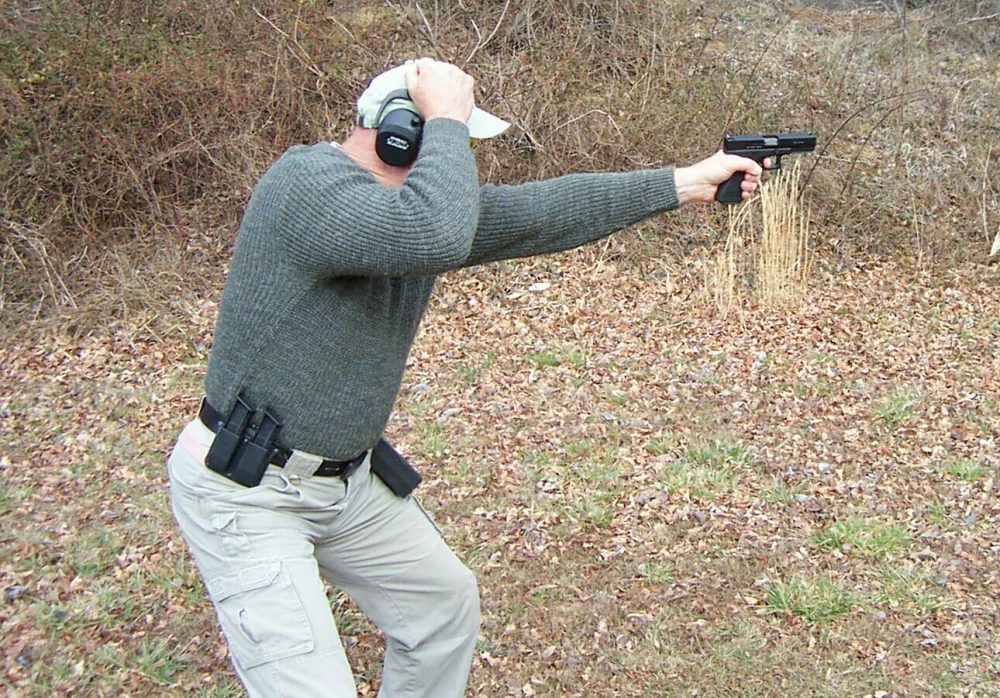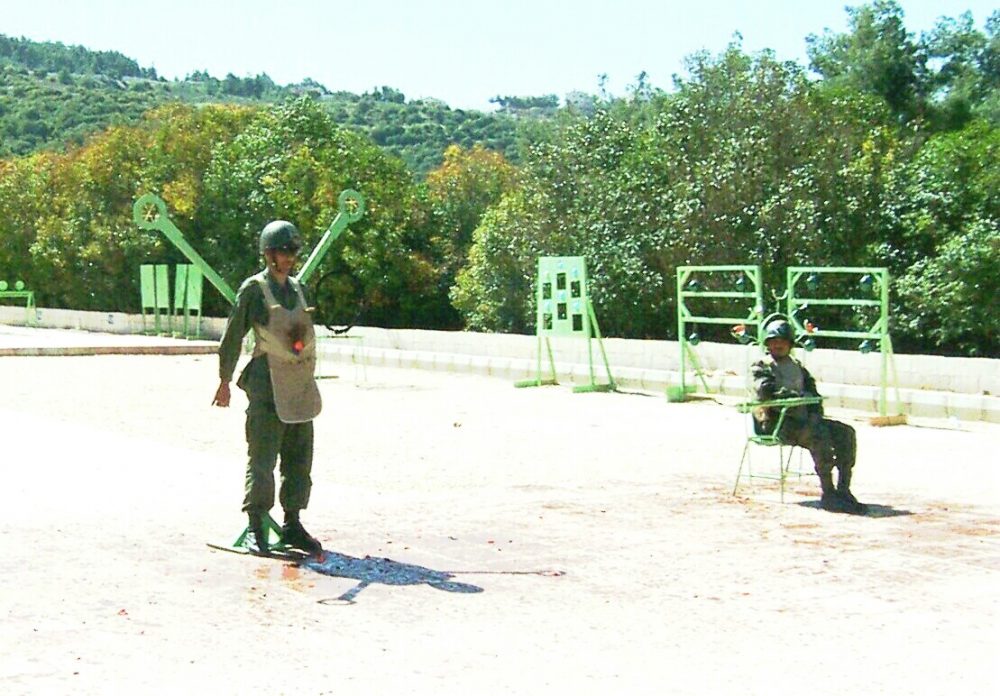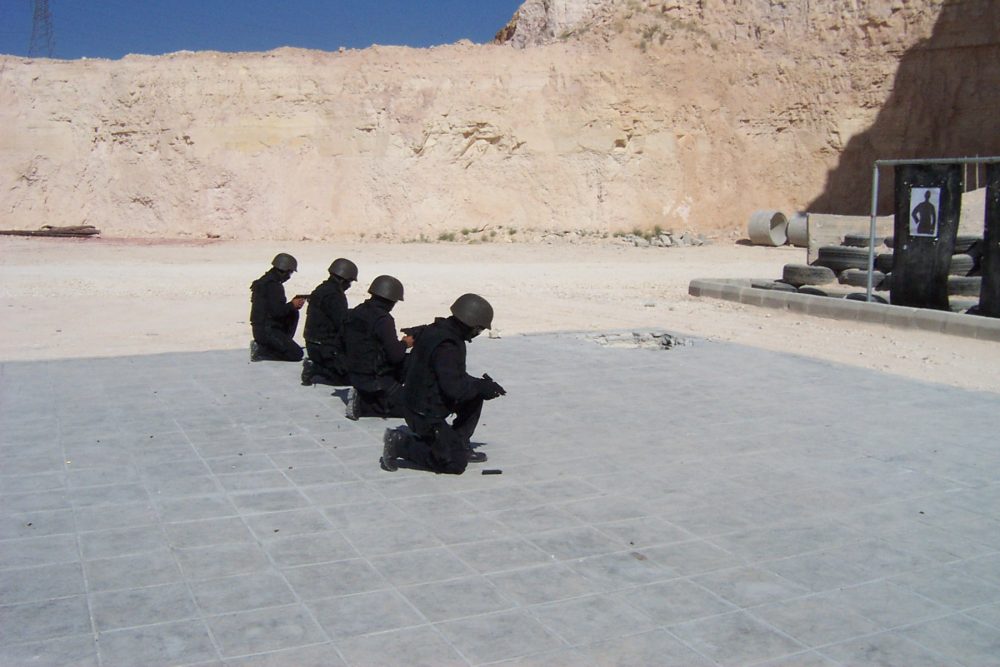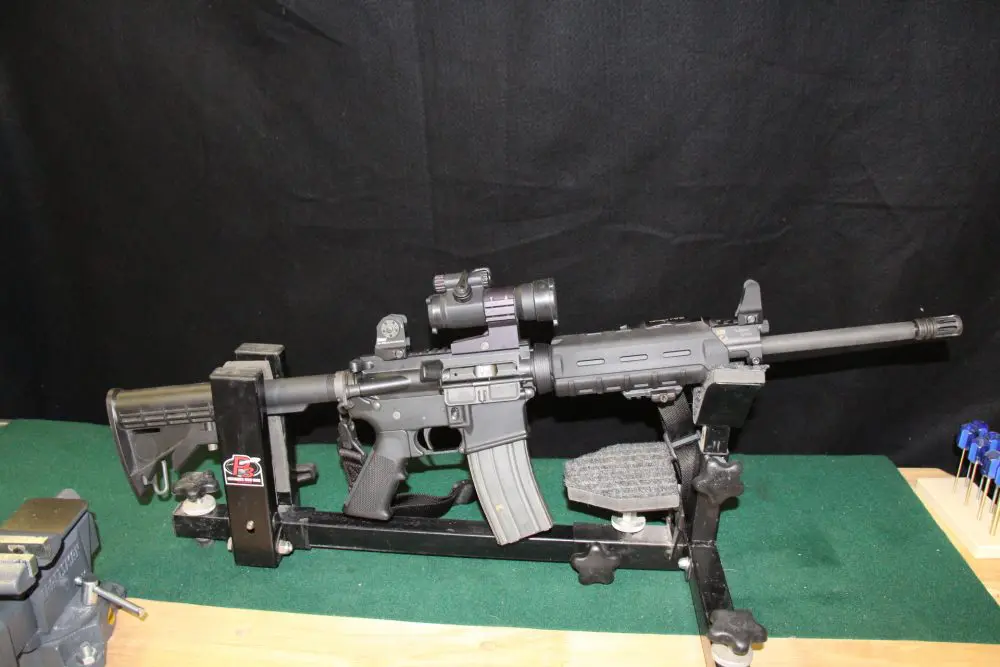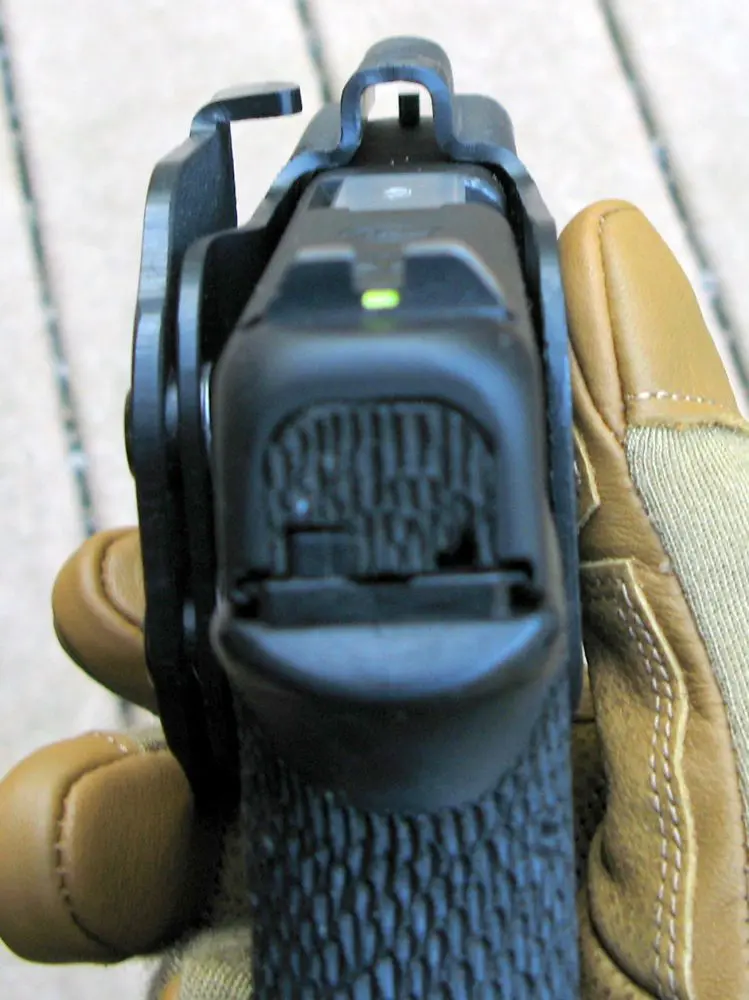Force yourself to work with your support hand.
I have had a gun of one type or other in my hand for the better part of 40 years and consider myself, if you will, a “Gun Maven.” Others might say, perhaps more accurately, that I am just another old “Gun Crank,” but I take firearms ownership and skill maintenance very seriously, and it is my responsibility to honor the Second Amendment and the tremendous privilege that it extends to us as a free people by working with my firearms whenever possible.
Realizing that shooting skills are perishable, I am on the range a few times per week, either honing my skills or evaluating a firearm for an article. And it has paid off, because as I enter my seventh decade of life, wearing glasses is an option rather than a necessity for me. Shooting sessions are comparatively short and only 100 rounds or so are expended, so I only focus on a couple of techniques and keep it pretty simple. That got me wondering what some of my famous and not so famous—but highly competent—shooting brethren do to keep sharp behind the right end of a gun? So, I sent out the word, and this article is a distillation of what a number of nationally ranked competitors and professional gunmen (some of whom have busted caps against flesh and bone as well as paper and steel) do to remain current with their sidearm.
Body armor-wearing Middle Eastern students, some from countries hostile to U.S., exhibiting confidence in their colleague’s shooting skills.
Table of Contents
WALT RAUCH, SECRET SERVICE, RETIRED
Walt Rauch is familiar to all who read this magazine and he certainly qualifies as a member of the Gun Maven fraternity. During his extensive law enforcement career, he has put bad guys under the muzzle of his gun, as well as competing on a national level. Like me, he has cut back on his formal training and, after reaching a relatively high plateau, he desires only to spend enough trigger time to maintain that level of performance. As a gun commentator, he tests and evaluates about 30 guns a year, which leaves little time for other shooting.
Depending on range use, Walt focuses on two- and one-handed shooting at five to 10 yards, precision long distance and, when possible, shooting on the move with both primary and backup guns. He enjoys hitting small targets at extended ranges, which forces him to constantly review trigger control and exercises his eyes so they can hold a sharp sight picture. No set time or round expenditure is involved, and he shoots until satisfied.
Walt further advises, “After a long life behind guns, the most important skill for me now is my acquired and reflexive familiarity with them. Frequent handling and occasional dry firing accomplish this.”
Mideast counter-terrorist teams have been exposed to modern pistol techniques. Skills are often shared with hostile countries and other anti-U.S. entities.
FEDERAL AGENT AND NATIONAL COMPETITIVE SHOOTING CHAMPION
This agent is also a member of a national counter-terrorism asset and frequently goes in harm’s way armed with long and short weapons. Subsequently, he cannot comment on tactical training, but is more than happy to share his general approach to his preparation for USPA/IPSC and IDPA shooting events.
When back at the compound and if duties permit, he works out on the range with paper and steel approximately two hours a day, expending up to 300 full power rounds per session to maintain match strength and endurance. Most of his competition is with limited/duty pistols in 9mm, .40 S&W and .45 ACP calibers. While basics are always reviewed, because sound basic skills and the ability to execute them on demand are the path to good performance, most of his time is spent on advanced drills.
During his training, he “reads his target and the groups on them hard.” His goal is to score between 85 and 90% “A” zone hits. After 100 rounds (distributed over several targets), he scores them. If the results show that he has achieved the above goal, then he knows that he is performing at optimum speed and accuracy. If the score is below 85%, he is shooting too fast and, if it is above 90%, he is too slow. With established drills, he knows what his times should be to complete, and he employs a timer to measure his effort, but still adheres to the 85/90% standard. This gets more challenging when he is speeding up his “A” zone acquisition and driving the gun’s sights faster from target to target. Finally, as do most top shooters, he has a mental conditioning program to follow.
Federal agent trains on moving targets while also moving.
SENIOR FEDERAL AIR MARSHAL
As a close quarters combat specialist, I begin every session with precision small dot drills as promulgated by the trainers’ trainer, John Shaw. I start out fully extended, then from the ready and finally out of the holster. Baseline gun fighting skills are next, and include speed draws, reloads, multiple shots and targets, facing movements, one-handed drills and alternate body target areas. Defensive shooting while moving dynamically in all directions is emphasized, but all activity is capped off by returning to precision fire to reinforce the fundamentals.
For variations on the theme, extreme close quarter drills involving hand and elbow strikes and blocks and shooting at very high speed are included, after warming up with a precision phase. Training takes one to two hours, and 300 to 500 full power .357 SIG rounds are expended.

TIER ONE, MILITARY SPECIAL FORCES OPERATOR
As you know, we have been armed with the 1911A1 for years and like the big bore caliber that’s been around for almost a century. The military is currently looking at new pistols, but in the all-American .45 ACP caliber. My unit has also had the advantage of training with the world’s finest combat shooters, so our program, in my opinion, is second to none. For security reasons I cannot discuss our team, squadron or cell’s training, and each of these entities is somewhat different than the others regarding what is emphasized. I will however, outline my own personal drills here.
Some of the practice is oriented toward improving my fighting skills, but because I compete in USPA/IPSC and IDPA, other aspects are devoted to winning matches. I acknowledge that some of the things that you have to do to win a trophy do not prepare you to take out people on a battlefield, but I feel the value of competition—induced stress—overshadows its limitations and negatives.
If I am trying to refine my unit combat techniques, I will train with my battle dress on, often with a long gun and with my pistol in its thigh holster. All my draws and presentations will be from the transition or “surrender” position, and I will be coming down on the handgun from shoulder level. I will also be wearing flame resistant gloves, which gives a different feel for the trigger.
Some of the things we do while on the range conducting personal training are a total violation of range safety rules, but we do them to save time. There are no ”cease–fires” while other operators go forward to check their targets on a known distance range. I could be shooting precision from the 50-yard line and another team member several yards to my left or right could be engaged in speed shooting drills at the seven. We trust each other and our skills implicitly, and to interrupt each other’s firing sequence would extend after duty hours sessions to unacceptable lengths of time. Needless to say, our muzzle control and trigger finger discipline are excellent, but collective shooting house training will see personnel sweeping each other with their muzzles—particularly when long guns are slung from three-point tactical slings. Negligent discharges are grounds for dismissal from the team, which most of us fear more than death.

Most of the time, I will warm up with precision drills, because accuracy is paramount and fundamentals cannot be neglected. If I am confined to shorter ranges, I will use reduced targets for this and concentrate on bullet placement with single and multiple shots. With my pistol, I am experimenting with advanced trigger techniques such as Rob Leatham’s method of trigger slap. With heavier recoiling calibers, this allows the barrel/slide to return to alignment before breaking an additional shot. Many of us rely on gun timing or engage in rhythm shooting to deliver multiple hits, even though we are tracking the front sight. This practice will result in more than a few shots going high, which may not be of consequence in competition, but can be critical during a hostage rescue assault. The trick is to learn how to do it fast without disturbing gun alignment.
Speed is also essential in this business, and transition from long to short gun drills is included in every session. If I do not have my carbine or submachine gun, all my draws will be from an aimed-in position with an imaginary shoulder weapon. To spice things up and get my combat motor running, I will have one of my mates rush me from the rear as I transition to see if I can get an accurate one- or two-handed shot before he smacks me in the head.
Although room combat can be confining, the majority of training involves movement and distractions. I want to be able to shoot from an unstable platform and at the same time be able to multi function. I may be moving in on a hostile target while also stiff-arming a three-dimensional, fully weighted, full sized dummy in the process. I will also yell commands to force me to be able to shoot simultaneously while my brain is focused on speaking or a nano second thereafter. I push the speed until my shots are so scattered that they would be marginally effective, and then I back it off a few notches until I am nailing the threat’s vital zones again. Currently, my command is placing more emphasis on cranial vault shots because of the proliferation of suicide bombers and potential WMD carriers. We have abandoned the two-body, one-head failure drill and emphasize either vertical tracking—especially while closing with a threat—or we hunt directly for the head. Red dot optical sights on our longs have made this more viable, and we are looking at some of the smaller and more compact versions for our pistols.
Shooting while on the move is mandatory skill.
In close, I incorporate a lot of hand fighting and weapons strikes to create distance or stun. We try to keep a bit of distance between the threat and ourselves, but physical contact during the various assault options is a given, and most shots are made within feet or at most a few yards from the hostile.
Multiple targets are a concern, because in most scenarios only a few operators during a team assault will enter a “hot room” and have to deal with the bulk of the bad guys. Others will come up with “dry holes,” unless blitzing to a known hostage/terrorist location. Target to target acquisition, employing “split hammers”—if in close proximity to each other—or “scanning” and “looking” techniques if threats are dispersed are practiced.
Full-auto fire with long guns is an operator option, but our SOPs generally involve aimed single fire to resolve most tactical problems. Our SOP is “All shots must be aimed shots, and we only shoot below eye level in an emergency situation.”
Sessions last at least two hours and I fire 200 to 300 rounds.

AL QAEDA OPERATIVE/FIREARMS INSTRUCTOR
(Fictitious. Extracted from al Qaeda/Taliban training manual)
Infidels. As some of you know through your contacts and training of foreign students from third world countries (some of whom have been our brothers working undercover, but wearing the colors of an ally), our handgun shooting skills are extremely poor. We are much more comfortable with our Kalashnikovs and edged weapons, but this is changing. Prior to the Afghan/Russian War, our previous military orientation had been British and by default the evil Russians who came to destroy us and Islam. However, because of the naïve assistance of America given us to oust the barbarians for their own greedy purposes, our training at all levels has advanced significantly.
I have been trained and educated at the university level in the United States and have competed in your combat matches, learning much. We have also come to realize that, for special operations, the handgun is an essential instrument and our new approach to developing skills with this weapon has, I believe, exceeded yours for police and military personnel. To apprise you of what you are up against and that we are no longer the cave dwellers you dismiss us as and that we are unstoppable, I will give you a glimpse of some of the advanced drills we have our operatives participate in.
We orient on the pistols or revolvers readily available in the area of operations, so our brothers are thoroughly acquainted with most U.S. and Russian sidearms. Basic handgun training runs 16 days and nights and is eclectic, covering every aspect of the art of pistolcraft, including assassination techniques, silencers and the use of mini guns. We are not slavishly dogmatic and we teach both Weaver and Isosceles stances and have also stolen from the Israelis their “Horse Stance.” Sighted and unsighted shooting with either individual hand or both hands is covered. Gun draws are executed from concealed carry, strong side, shoulder holsters and cross draw. One of our close combat shooting stances, which emphasizes gun retention especially when attacked by multiple assailants from different directions, resembles your “Center Axis Relock” technique. Safety is emphasized and we run “cold ranges.” Students are dropped from the course for safety violations.
General
- Shooting from pocket, folded newspaper and paper bag up to five yards.
- Employing both sighted and unsighted shooting (Point) at extended (35 yards) and close ranges (10 yards)
- Operators assuming all shooting positions, Weaver and Isosceles when conducting drills and with one and two hands. Kneeling, sitting and prone positions are included.
- Keeping both eyes open is emphasized.
- Movement is paramount and shooting while walking is conducted from bent arm hip, extended arm, point shoulder and two hands.
- Judgment and target discrimination are developed using color-coded targets.
- Using reduced and half-sized targets at all ranges emphasizes accuracy.
- Turning, moving and disappearing targets decrease reaction time, develop target tracking skills and increase speed of target engagement.
Reinforcing Accuracy
- Distance: 20 yards. Number of rounds: three. Target: Half sized. Target appears for one second. Shooter engages target as it appears with three rounds from ready gun. Exercise is repeated three times. Outstanding = three rounds on target. Very good = two rounds on target. Good = one round on target.
- Distance: 15 yards. Number of rounds: three. Target: Half sized. Target appears for one second from various directions (right, left and front). Shooter engages each target with one round. Scoring: same as above.
- Distance: 15 yards. Number of rounds: seven. Targets: Two full sized. Distance between targets: seven yards. Two targets appear simultaneously for three seconds. Outstanding = two rounds in each target. Very good = one round in one target and remaining rounds in second target or one round each target. Fair = one round in one target. Repeat exercise three times.
Speed And Specialized Shooting
- Distance: 15 yards. Number of rounds: seven. Target: Half sized. Using one hand, aim at head and obtain a hit in three seconds. Repeat six times.
- Distance: 10 yards. Repeat above drill without using sights.
- Distance: 15 yards. Number of rounds: 10. Targets: Two, full sized. One target is half obscured by “hostage target.” From the holster, draw and fire two rounds, one handed while standing still, at the hostile target in three seconds. Repeat while shooting at a walk, with two hands. Repeat four times.
- Distance: 15 yards. Number of rounds: five. Targets: Two, full sized. Stance: Standing, two hands. Holster is worn on strong side. Two targets appear from different directions for four seconds. Shooter draws and fires five rounds at both targets. Outstanding= two rounds each target. Good = one round initial target and remaining rounds second target. Repeat three times with targets appearing right, left and front.
- Distance: 10 yards. Number of rounds: three. Target: Half sized. Gun is not loaded. When target appears for two seconds, gun is drawn, loaded and fired. Repeat three times. Outstanding = one hit on target.
- Distance: 10 yards. Number of rounds: five. Target: Two half sized targets. Shooter lying in bed. Targets appear for 3.5 seconds. Shooter retrieves handgun and engages targets. Repeat same drill, but seated in chair.
- Distance: 10 yards. Number of rounds: five. Number of targets: Two half sized targets. Shooter is passenger in vehicle. Vehicle stops for two seconds and shooter draws and fires at targets. Repeat three times.
AUTHOR’S CONCLUSIONS
I have viewed several al Qaeda videotapes and they do not support what is set forth in their above ambitious manual. Mujahideen skills still appear to be primitive and more “Hollywood” than practical.
Ironically, although they hate Jews, they have adopted the Israeli “ Horse Stance” for their combat shooting stance, which indicates a mix of practical expediency with their ideology. Conversely, we in the U.S. labor under the oppressive weight of political correctness when it comes to obtaining ammunition manufactured by Israeli sources to reduce existing logistical shortfalls, because it would offend Muslims in general.
Although cover is emphasized in tactical manuals, no barricade training is included and, although once considered cowardly by the Afghan warrior, going prone appears to be an accepted tactic. While these enemy texts reinforce the fact that we are being confronted by a more sophisticated savage today, I believe our gun fighting skills and equipment are superior to Osama bin Laden’s disciples and will remain so as long as we do our part by continuing to prepare for the coming confrontations with his operatives.
The American contributors all stress one thing in common: Accuracy over speed, with the latter attribute considered essential, but kept in proper tactical context. Personal training time ranges from one to two hours maximum, with 100 to 300 rounds expended a few times a week. One handed shooting is a must and, if armed with a primary long gun, both are integrated into training.

